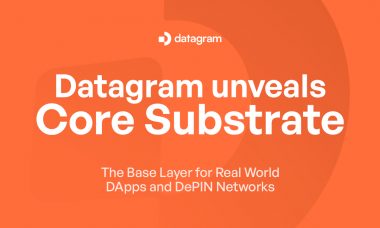Datagram unveils core substrate, the baselayer for real-world dApps and DePIN networks

Share this article
Tortola, British Virgin Islands, April 3rd, 2025, Chainwire
Datagram has unveiled its Core Substrate, a fully operational, connectivity baselayer built specifically to power real-world applications and DePIN (Decentralized Physical Infrastructure Network) networks. The substrate is live and in partnership discussions with major blockchain infrastructure ecosystems.
The Core Substrate enables the deployment of custom DePIN networks, allowing developers to build dedicated decentralized systems atop Datagram’s infrastructure—comparable to building on frameworks like the Cosmos SDK or Polkadot’s Substrate, but with immediate access to a live, scalable node network. Projects can launch full-service platforms across a wide array of verticals, including content delivery networks, AI applications, decentralized SaaS tools, and more.
Additionally, Datagram provides a drop-in decentralized alternative to centralized cloud infrastructure. Applications currently reliant on providers such as AWS for file storage, communication layers, multiplayer synchronization, or distributed compute can migrate to Datagram’s platform—typically at a 70–90% reduction in cost, with enhanced privacy protections, no vendor lock-in, and no need for blockchain-specific knowledge or engineering resources. All on-chain activity remains automated and abstracted.
“What we really are is a substrate and foundation upon which other DePINs can be built and can operate,” said Jason Brink, Co-Founder of Datagram. “When you think of Ethereum, you think of token launches. When you think of Solana, you think of meme coins. When you think of DePIN, you should think of Datagram.”
Many blockchain-based platforms rely on existing frameworks or forks. Datagram’s infrastructure platform is a proprietary system, built from the ground up. It draws on decades of distributed systems expertise and introduces several technological firsts—including the successful delivery of UDP-based, real-time communication over a decentralized network. This capability enables new categories of decentralized applications, including voice and video services, multiplayer gaming platforms, AI inference layers, and low-latency compute workloads.
The Datagram decentralized infrastructure platform features an abstracted Web3 architecture, meaning businesses onboard without engaging directly with blockchain infrastructure. Transactions and service usage can be paid via Datagram’s native token ($DGRAM) and fiat such as credit card, while on-chain mechanisms operate in the background—triggering token consumption, rewarding node operators, and contributing to the integrity and economic alignment of the network. This approach enables Datagram’s protocol-to-business-to-consumer model to offer decentralized infrastructure with the accessibility of conventional enterprise SaaS platforms.
This release marks forward progress for the DePIN sector, which has often been characterized by early-stage projects and unproven concepts. Datagram’s Core Substrate enters the market with established adoption, live deployments, and measurable performance at scale. Its architecture enables end users and businesses to interact with decentralized infrastructure—often without realizing it—while benefiting from the performance, reliability, and cost-efficiency of a next-generation network.
About Datagram
Datagram is a global, AI-driven Hyper-Fabric Network redefining the new era of Internet connectivity and DePIN cross-network interoperability. By harnessing idle hardware and bandwidth, the network dynamically optimizes traffic, reduces congestion, and scales effortlessly to deliver seamless, low-latency performance across gaming, AI, telecom and beyond. Having served over 200 enterprises and 1 million users worldwide, Datagram is the next-generation baselayer for DePINs and high-performance applications.
Website | Discord | Telegram | LinkedIn | X
Contact
Chris
[email protected]
